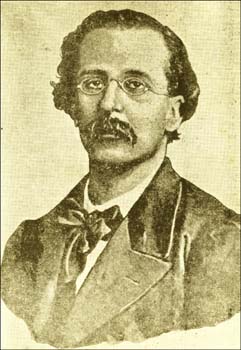2.1.11 The poetic work of Juan Clemente Zenea (1832 – 1871)

Although Zenea assimilated the country’s lyrical tradition, the presuppositions of the Cuban Romantic school and the nativism that was at the foundation of the thriving feeling of nationality, his poetic incursions indicate that the author drank from universal sources, even detaching himself somewhat from Spanish Romanticism – except for the poetics of Bécquer, whose sensibility he was very close to – and developing creative lines linked to the Romantic movements that were taking place in France and England.
The landscape plays a new role in his work, not as a symbol of island identity but as a painting to which he transfers his emotional state, a characteristic of almost all European Romanticism. His verses produce the impression of being the fruit of a sudden and sustained inspiration, which draws him to an inner world marked by absence, incorporeality, and evocative nostalgia; however, a more careful reading reveals the exquisite treatment of clichés and formal chiseling, with a stylistic intent that does not negate expressive fluidity.
His best-known poem, and one of the best-composed in the history of national lyric poetry, has undoubtedly been “Fidelia,” which culminates with the following stanzas:
“I remember well! Ten years ago!
And it was a serene afternoon!
I was young and enthusiastic,
Pure, beautiful and virgin she!
We were in a forest
Sitting on a stone,
Looking at the banks of a river
How the grasses trembled.
I am not who I was then,
Heart in spring,
Flame that rises to the heavens,
Soul without guilt or sorrow
You are not the same either,
You are no longer who you were,
The destinations have changed:
I am sad and you are dead”
The “trembling of the grasses” seems to allude to the lovers’ own physical and spiritual state, the delightful uncertainty that one being can awaken in the other, but all within the placidity and confabulation of the surroundings with the amorous encounter. This past is contrasted with the desolate present in almost every stanza, provoking a growing melancholy, characteristic of the elegiac tone that characterizes this and other poems with a strong romantic influence.
Regarding his place within Romanticism, Raúl Roa stated: “Zenea knew, like few others, how to infuse poetic substance into the thick treacle of literary sentimentality and rhetorical lament. One of his most notable achievements is having gracefully overcome the ravages (…) of deliquescence and wailing.” Zenea’s Romanticism was authentic in its tragic vision of existence; it was not merely a literary pose. His fate, like that of so many others who wrote and lived according to the canons of this movement, came to brutally confirm this.
Regarding Zenea’s political stance, in his verses he condemned the execution of Narciso López in 1851, who led an armed expedition to Cuba with the aim of provoking an uprising against Spain. The annexationist sentiment he advocated, although not a valid option for the country, constituted a manifestation of anti-Spanish sentiment, and Zenea ultimately sympathized with this sentiment and with Narciso López’s unquestionable bravery.
However, in 1870, the poet traveled clandestinely to Cuba from the United States on a mission for the New York Board of Information. At the same time, he carried a safe-conduct pass from the Spanish ambassador to the United States and, apparently, a proposal for autonomy for the insurgents. These circumstances have not been fully explained, but Zenea was captured and shot at the Cabaña fortress in August 1871.
The poetic pieces he created in prison, collected in “Diary of a Martyr,” express above all his love for his wife and daughter and the evocation of the warm family atmosphere. They contain no references to his homeland and do not reveal feelings of guilt, but rather a surprising moral integrity in the face of the imminence of death.








